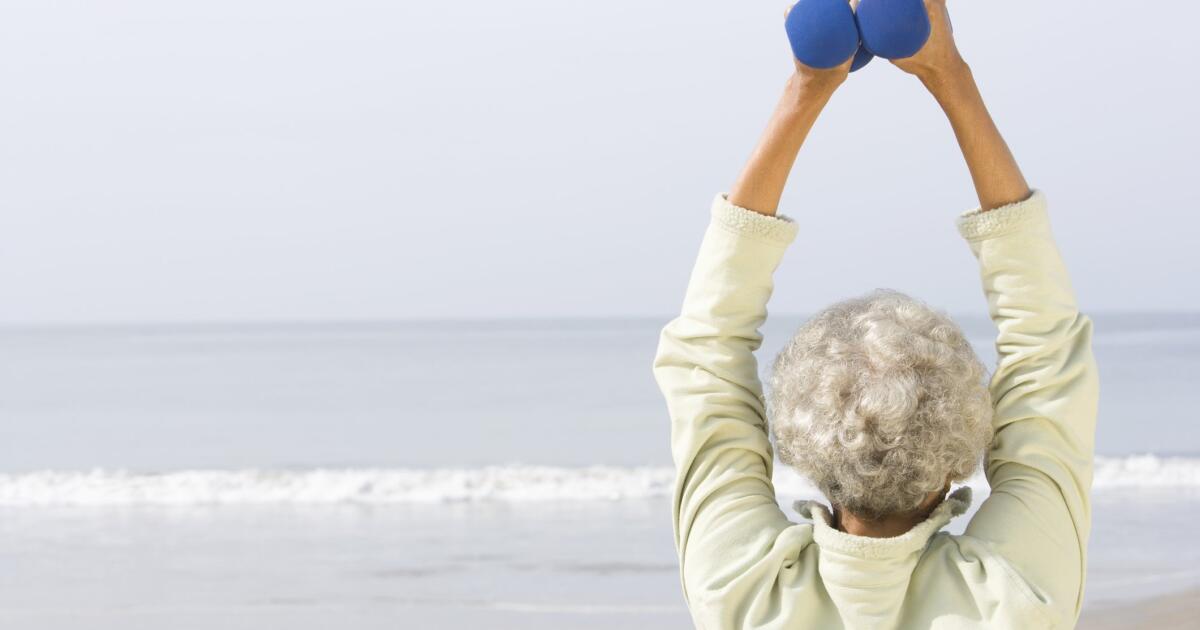Health
What is a Healthy BMI for a 70-Year-Old Female?



—
This content is for informational purposes only and is not intended to provide medical advice.
BMI stands for Body Mass Index. It’s a simple number calculated from a person’s weight and height, providing a reliable indicator of body fatness for most people.
How is BMI Calculated?
Calculating BMI is straightforward. You take your weight in kilograms and divide it by the square of your height in meters.
Here’s the Metric formula:
BMI= Weight (kg) / Height (m)2
Or
[weight (kg) / height (cm) / height (cm)] x 10,000
For example, if you weigh 70 kilograms and are 1.6 meters tall, your BMI would be:
BMI= 7/(1.6)2 = 27.34
Check Your BMI Easily
For those looking to quickly and accurately calculate their BMI, the Modern60 BMI calculator is a handy tool. It offers an easy way to input your weight and height to determine your BMI, helping you stay informed about your health status. Adrian, a Health expert from Modern60, emphasizes the importance of regularly checking your BMI as part of a comprehensive approach to health management.
Importance of BMI in Assessing Overall Health
BMI is an important tool because it helps gauge whether you’re within a healthy weight range for your height. Maintaining a healthy BMI can lower your risk for health problems like heart disease, diabetes, and other conditions. For seniors, particularly those around 70 years old, understanding and managing BMI is crucial for maintaining overall well-being and longevity. It gives a general idea of whether you might need to gain or lose weight to improve your health.
BMI Categories
BMI categories help to classify a person’s weight relative to their height, indicating potential health risks associated with different weight ranges. Here are the main categories:
Underweight: BMI Less Than 18.5
If your BMI is less than 18.5, you are considered underweight. Being underweight might indicate malnutrition, osteoporosis, or other health issues. It’s important to seek advice from a healthcare provider if you fall into this category to ensure you are getting the necessary nutrients for good health.
Normal Weight: BMI 18.5 – 24.9
A BMI between 18.5 and 24.9 is considered normal or healthy weight. This range is associated with the lowest risk of developing weight-related health problems. Maintaining a BMI in this range generally indicates a balance of appropriate weight and height, contributing to overall well-being.
Overweight: BMI 25 – 29.9
A BMI between 25 and 29.9 is categorized as overweight. While this doesn’t necessarily mean you are unhealthy, it may increase your risk for conditions such as heart disease, high blood pressure, and type 2 diabetes. It’s a good idea to consult with a healthcare provider for advice on achieving a healthier weight.
Obesity: BMI 30 and Above
A BMI of 30 or higher is classified as obesity. This category significantly raises the risk of numerous health issues, including cardiovascular diseases, diabetes, and certain cancers. Managing obesity often requires a comprehensive approach involving diet, exercise, and possibly medical intervention. Seeking guidance from a healthcare provider is crucial for addressing obesity and improving overall health.
Specifics for Seniors
How BMI Ranges May Differ for Older Adults
As we age, our bodies undergo various changes that can affect BMI. For seniors, especially those around 70 years old, the standard BMI ranges might not fully capture their health status. Factors like muscle mass, bone density, and fat distribution shift with age, potentially altering what is considered a healthy BMI.
Changes in Muscle Mass, Bone Density, and Fat Distribution
- Muscle Mass:Older adults often experience a decrease in muscle mass, known as sarcopenia. This reduction can lead to a lower weight and, consequently, a lower BMI.
- Bone Density:Bone density tends to decrease with age, contributing to changes in weight and BMI.
- Fat Distribution:Fat distribution changes as well, with more fat being stored around the abdomen, which might not be as accurately reflected in BMI.
Recommended BMI for 70-Year-Old Females
General Healthy BMI Range
For most adults, including 70-year-old females, a BMI between 18.5 and 24.9 is generally considered healthy. This range is associated with the lowest risk of health complications related to weight.
Personalized Recommendations
It’s crucial to consult with healthcare providers for personalized advice. They can take into account individual health conditions, lifestyle, and other factors to provide a more accurate assessment of a healthy BMI.
Acceptable Slightly Higher BMI
Due to age-related changes like muscle loss and shifts in fat distribution, a slightly higher BMI might be acceptable for older adults. This is because having a bit more weight can sometimes offer protective benefits against conditions like osteoporosis and malnutrition.
Health Implications of BMI
Risks Associated with Low BMI
- Malnutrition:Low BMI can be a sign of inadequate nutrition, which can weaken the immune system and reduce muscle strength.
- Osteoporosis:Insufficient weight can lead to bone density loss, increasing the risk of fractures and osteoporosis.
Risks Associated with High BMI
- Cardiovascular Disease:Excess weight can strain the heart, leading to conditions like high blood pressure, heart attacks, and strokes.
- Diabetes:Higher BMI is associated with an increased risk of type 2 diabetes, which can lead to various complications if not managed properly.
Importance of Maintaining a Balanced BMI
Maintaining a balanced BMI is crucial for overall health and longevity. It helps in reducing the risk of chronic diseases, improving mobility, and enhancing the quality of life.
Factors Influencing BMI in Seniors
Chronic Conditions
Chronic conditions like arthritis, diabetes, and heart disease can impact weight and BMI. These conditions often require medication and lifestyle changes that can affect overall body weight.
Medications
Many medications can influence weight, either by increasing appetite, causing fluid retention, or leading to weight loss.
Physical Activity Levels and Metabolism
Physical activity levels often decrease with age, leading to a slower metabolism. This can result in weight gain if dietary habits remain unchanged.
Best Tips for Maintaining a Healthy BMI
Balanced Diet Recommendations
- Nutritious Foods:Focus on nutrient-dense foods like fruits, vegetables, whole grains, lean proteins, and healthy fats.
- Portion Control:Eating smaller, more frequent meals can help manage weight and ensure adequate nutrient intake.
Importance of Regular Physical Activity
- Walking:Regular walks can improve cardiovascular health and aid in weight management.
- Yoga:Gentle yoga helps with flexibility, balance, and strength.
- Light Resistance Exercises:These can help maintain muscle mass and support metabolic health.
Staying Hydrated
Adequate hydration is essential for overall health and can help regulate metabolism and digestion.
Regular Health Check-Ups
Frequent check-ups with healthcare providers help monitor weight, BMI, and overall health. They can offer personalized advice and adjustments to diet or exercise routines as needed.
Additionally, for great deals and discounts on health-related products and services for seniors, you can visit Discount for Seniors.
Conclusion
Maintaining a healthy BMI is vital for overall well-being, especially for seniors. It helps reduce the risk of chronic diseases, supports mobility, and enhances quality of life. A balanced BMI indicates that your weight is appropriate for your height, contributing to better health outcomes.
While BMI is a useful tool, it’s essential to remember that everyone is different. Consulting healthcare providers for personalized advice ensures that your health plan considers all factors, including existing medical conditions and lifestyle. Making small, manageable changes to your diet and exercise routine can have a significant impact on your BMI and overall health. Focus on consistency and gradual improvements to create lasting habits that support a healthy weight and well-being.
References
World Health Organization (WHO). “Body Mass Index (BMI).” Retrieved from WHO.
World Health Organization (WHO). “A Healthy Lifestyle – WHO Recommendations.” Retrieved from WHO.
Centers for Disease Control and Prevention (CDC). “About Adult BMI.” Retrieved from CDC.
National Heart, Lung, and Blood Institute (NHLBI). “Calculate Your Body Mass Index.” Retrieved from NHLBI.
—
This content is brought to you by Chris Reyes
Health
New Study Says Aging Well Is Connected to Hearing Well

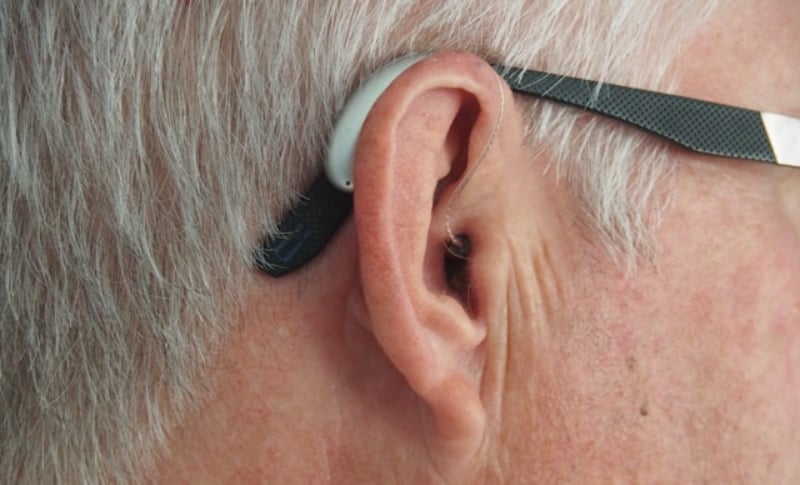

By Patty Wellborn
As Canada’s population continues to age—people 65 years and older are part of the fastest-growing age group in Canada—researchers and health-care providers continue to look for ways to keep seniors as healthy as possible.
Dr. Kathleen Martin Ginis, is the Director of UBC Faculty of Medicine’s Centre for Chronic Disease Prevention and Management and a Professor with UBC Okanagan’s School of Health and Exercise Sciences. Dr. Martin Ginis recently worked with colleagues from Johns Hopkins University who led a study investigating the link between a senior’s hearing and their physical activity level.
Using data from an American National Health and Aging Trends Study, the research team studied the association of hearing loss with activity level. More than 500 participants, with a mean age of 79 years, participated by wearing accelerometers for one week and self-reporting their vigorous physical activity and walking exercise for one month. The goal was to investigate the association between physical activity and hearing loss as well as physical activity and hearing aid use. The results were published recently in The Journals of Gerontology: Series A.
Dr. Martin Ginis explains why studies like this are necessary and the important link between hearing capacity and keeping active.
Why is it important to understand the relationship between physical activity and the ability to hear well?
Hearing loss is associated with frailty, poorer physical function and falls. Low levels of physical activity are also related to these health problems. There has been very little research on whether physical activity levels and hearing loss are related in older adults, and whether the use of hearing aids makes a difference.
If we can determine that link, then health-care providers can better support older adults in maintaining an active lifestyle and researchers can focus on studying the impact of hearing interventions.
What’s the connection?
There are several potential mechanisms through which hearing loss may contribute to physical inactivity. These include a decline in the perception of environmental auditory cues while moving about, a feeling of social isolation and increased allocation of cognitive resources for listening, leaving limited attention for simultaneous tasks.
Think about the places where older adults might go to do physical activity—to community centres, public swimming pools, for walks in their neighbourhoods. If their hearing is impaired, it is going to be difficult to interact with fitness leaders or staff in these public spaces, and it may even be frightening or dangerous to move about the community if you can’t hear what is going on around you. These factors will limit a person’s activity levels.
How did you gather your data for this study?
We used data collected from a nationally representative sample of older adults in the United States. The participants had clinical-standard audiometric hearing testing and wore an accelerometer for one week to measure their physical activity levels. They also completed a couple of questions about their activity over the past month and provided information on their hearing-aid use.
What did the study determine?
We found that older adults with hearing loss did less physical activity than adults who could still hear well. As hearing loss increased, the number of minutes of physical activity performed each day decreased. The good news, however, was that among adults with hearing loss, those who used a hearing aid were more likely to report that they walked for exercise compared to those who did not use a hearing aid. These patterns held for both men and women in the study.
So, making use of a hearing aid can help keep hearing-impacted seniors more active?
Based on our findings, it seems that using a hearing aid may help to address the impact of hearing loss on physical activity. This makes sense. Hearing aid use may alleviate challenges associated with communicating with people in physical activity spaces—for instance, recreation centres and exercise programs—and reduce the cognitive processing demand in environments where the person needs to attend to auditory cues.
We hope our findings will encourage seniors to have their hearing checked on a routine basis, and if they are experiencing hearing loss, to use hearing aids. Better hearing is related to more time spent on physical activity. And physical activity has a wide range of health and function benefits for older adults.
Media Contact
Patty Wellborn
Media Relations Strategist
University Relations
UBC Okanagan
Tel: 250 317 0293
E-mail: [email protected]
—
Previously Published on ubc.ca with Creative Commons License
***
Join The Good Men Project as a Premium Member today.
All Premium Members get to view The Good Men Project with NO ADS.
A $50 annual membership gives you an all access pass. You can be a part of every call, group, class and community.
A $25 annual membership gives you access to one class, one Social Interest group and our online communities.
A $12 annual membership gives you access to our Friday calls with the publisher, our online community.
Register New Account
Need more info? A complete list of benefits is here.
—
Photo Credit: unsplash
Health
Should Colon Cancer Screening Start at 40?



By Alvin Powell | Harvard Staff Writer | Harvard Gazette
Medical and public health professionals are seeing a worrisome trend of rising early onset rates for certain cancers and wrestling with what the most appropriate response might be.
In April, the U.S. Preventive Services Task Force lowered the recommended age to start breast cancer screening to 40 from 50, citing high mortality and a rising incidence among U.S. women age 40 to 49 for the change. Data showed a 2 percent annual increase in diagnoses from 2015 to 2019.
Colorectal cancer has tracked a similar, perhaps even more worrisome, trajectory in recent years. It has seen an even steeper rise of early onset cases, up 15 percent among those age 40 to 49 between 2000 and 2016. The second deadliest after lung cancer, it kills more people than breast cancer — an estimated 52,550 in 2023.
The Gazette asked colorectal cancer experts at Harvard Medical School-affiliated hospitals whether the colorectal cancer screening age should be lowered to 40 from the current 45.
Many of the younger patients are being diagnosed in their late 20s to 30s
Ted Hong, professor of radiation oncology, HMS; director of the Gastrointestinal Service, Radiation Oncology Department, Mass General Cancer Center
This is a complicated issue. While there is clearly a dramatic rise in colorectal cancer in young patients, it’s not clear that 40 is the correct age. Many of the younger patients are being diagnosed in their late 20s to 30s and moving the screening to 40 may not capture this group of patients, while dramatically increasing cost and utilization. Ultimately, other tests, be it blood-based or stool-based, to direct younger patients at risk to earlier colonoscopy are needed.
Early screening involves risks and additional upfront costs
Tyler Berzin, associate professor of medicine, HMS; director of the Advanced Endoscopy Fellowship program, Beth Israel Deaconess Medical Center
It would be a “not yet” for me right now. In the last couple of decades there has been a nearly 50 percent increase in colorectal cancer diagnoses in individuals under the age of 50. An increase like this can’t be due to genetic factors, which don’t change in the population over that period of time, so the rise in early onset colon cancer is likely related to various environmental and lifestyle risk factors: the types of foods we consume, alcohol use, and obesity, among many other considerations.
Colorectal cancer is now the top cause of cancer death in men under 50 and the second-leading cause in women under 50. Compared to most other types of cancer screening, where the aim is to catch cancers at an early stage, we have a unique advantage in colon cancer screening because we can identify and remove theprecursor lesions — colon polyps — many years before they actually turn cancerous. For this reason, it does make sense to ask the question of whether to recommend earlier screening to identify and remove precancerous polyps before the currently recommended screening age of 45 (for average risk individuals).
There is no doubt that moving the colon cancer screening age to 40 would catch and prevent a few more cancers. But early screening involves risks and additional upfront costs and may shift how we allocate resources. For instance, in some areas of the country with relatively few gastroenterologists, there are already long waits to get in for colonoscopy screening.
The reality is we’re still not doing nearly a good enough job getting most 45-year-olds or even 50-year-olds, screened for colon cancer, and we do a particularly poor job for disadvantaged and vulnerable groups — including the uninsured and underinsured. So changing the colon cancer screening age to 40 can’t be considered in isolation. We have to balance a variety of health care access and cost considerations to determine if it’s the right move for average risk individuals in the U.S.
If there was a biomarker to identify risk, this would help us understand who to screen early
Aparna Parikh, associate professor of medicine, HMS; medical director, Center for Young Adult Colorectal Cancer at Mass General Cancer Center
As an oncologist who sees largely young patients, my bias is to screen earlier. But we have to be mindful of the population-level implications of continuing to lower the screening age. Ideally, we start to understand the drivers and which younger individuals may be prone to develop CRC in order to offer early screening to the right patients. If there was a biomarker to identify risk, this would help us understand who to screen early. Many of my patients are in their 20s and 30s. Expanding the screening eligible age may be a good space for stool- and blood-based screening and risk stratification to get the right people to colonoscopies efficiently.
Adherence to screening remains low in the U.S.
Marios Giannakis, associate professor of medicine, HMS; gastrointestinal oncologist at Dana-Farber Cancer Institute
Early onset colorectal cancer, defined as colorectal cancer diagnosed in individuals younger than 50 years old, is a rising epidemic. In recognition of this, several major organizations and societies have adjusted the recommended screening age for colorectal cancer. For example, the [Preventative Services Task Force] now gives a Grade B recommendation for screening individuals ages 45 to 50 versus a Grade A recommendation for those ages 50-75, and the American Cancer Society (ACS) a qualified recommendation versus a strong recommendation for older individuals. These guidelines instruct physicians to recommend screening to their eligible patients.
It is also true that early onset colorectal cancer affects numerous individuals younger — and sometimes much younger — than age 45. Whether to further reduce the screening age for the general population is a complex decision that these bodies and societies think carefully over, examining not only the incidence of early onset colorectal cancer, but the available resources and cost to society and patients of a more expanded screening program.
It would be a little presumptuous for one — including an expert — physician to assume this role. What has become as clear as the rise in early onset colorectal cancer is that adherence to screening remains low in the U.S. and that underserved populations are particularly vulnerable. Thus, thinking about equitable access to the currently recommended care and advancing the scientific mission of understanding the etiology of early onset colorectal cancer in order to identify those at the highest risk and tailor prevention and screening may well be a more sustainable long-term solution.
Only those with the means to afford it would take part
Shuji Ogino, professor of pathology, HMS; professor of epidemiology, chief of molecular pathological epidemiology in the Department of Pathology, Brigham & Women’s Hospital
It depends. First, we need to have and evaluate more data on comparative effectiveness analyses of costs and benefits of setting universal screening start age at 40 versus 45 years. It is unlikely that a universal colonoscopy start age of 40 years will be cost-effective. Fecal occult blood testing may be more cost-effective, but it has some degree of false-positive findings, which necessitates additional tests (that may be unnecessary to begin with). Thus, we need more research in this area.
It can be possible that, based on genetic and life-course risk factor profiles, screening start age could/should be tailored. However, we lack comprehensive information on effects of various genetic, life-course risk factors and their interactions at this time. Ideally, one can start colonoscopy screening at age 40 years or even younger. However, such a practice will increase health disparities and inequities, as only those with the means to afford it would take part. We could not rely on financially unsustainable universal insurance coverage for universal screening starting at a young age.
Focus more on identifying the underlying causes
Andrew Chan, Daniel K. Podolsky Professor of Medicine, HMS; professor of immunology and infectious diseases, Harvard T.H. Chan School of Public Health; director of cancer epidemiology, Mass General Cancer Center
To address the unprecedented increase in incidence in colorectal cancer diagnosed before the age of 50, it would be tempting to simply lower the age at which we begin screening to 40 years. However, we must also consider the tremendous resources that would need to be devoted to such an effort. Such a major broadening of the eligibility for screening would likely be an insurmountable cost to the healthcare system and divert attention from other important needs. Instead, I would argue that we should focus more on identifying the underlying causes of this rise in early onset cases so that we can focus on efforts to eliminate or reverse them.
—
This story is reprinted with permission from The Harvard Gazette.
***
You Might Also Like These From The Good Men Project
Join The Good Men Project as a Premium Member today.
All Premium Members get to view The Good Men Project with NO ADS. A $50 annual membership gives you an all access pass. You can be a part of every call, group, class and community. A $25 annual membership gives you access to one class, one Social Interest group and our online communities. A $12 annual membership gives you access to our Friday calls with the publisher, our online community.
Register New Account
Need more info? A complete list of benefits is here.
—
Photo credit: iStock
Health
Goat Cheese And Caramelized Onion Pizza

This goat cheese and caramelized onion pizza is my favorite restaurant-quality meal I make at home! I love how easy this recipe is to make. The crispy crust paired with creamy goat cheese and sweet caramelized onions is a match made in heaven! My recipe is perfect for a healthier family-friendly pizza night that’s better than takeout, and more budget-friendly too.

If you know me, you know I love pizza. I’ll make it in all sorts of ways – from a quick pizza on naan bread, to stuffing the ingredients into zucchini boats, or combining the ingredients into a keto pizza bowl! No matter how I serve it up, I’ve found it’s impossible to go wrong with pizza and all the delicious toppings available.
And the first time I had a goat cheese pizza with caramelized onions, I knew I had to find a way to recreate it at home. My recipe brings together the sweetness of the onions and the tang of the goat cheese for a mouthwatering flavor combination!
When it comes to shaking up the regular pizza night rotation, I always start by experimenting with different cheeses. If that’s your jam too, I highly recommend trying my pear gorgonzola pizza after you make this recipe!
My goat cheese caramelized onion pizza recipe is gourmet without the complicated cooking process, which is perfect for elevating weeknight meals.
The crust is thin and crispy, adding a nice texture to the softer ingredients on top. The tangy goat cheese and sweet onions pair nicely with the crisp pizza crust, and the fresh thyme gives this pizza a hint of herbal richness. It’s way better than pizza delivery and healthier too!
I made a few swaps to increase the nutrition while reducing calories and fat and without losing any of the flavor, so this pizza leans to the healthier side of the usual fast food version.
Surprisingly, my kids also love this goat cheese pizza recipe. While this pizza is not the traditional kind they’re used to, they enjoy the cheesiness, along with the sweetness of the onions. Plus, when the kids aren’t around, I love to make this for a date night in! Either way, I’ve got dinner on the table in about an hour.
Latest Recipe Video!
🥘 Ingredients
I love a gourmet meal without a long list of ingredients! In fact, many of these ingredients I always have on hand in the pantry. Here’s what you need:

Whole Wheat Flour: My homemade dough starts with a combination of warm water, dried yeast, and a touch of honey. I use whole wheat flour or white whole wheat flour to add fiber which is important for healthy digestion, regulates blood sugar, and lowers cholesterol (source). Plus, it creates a more nutrient-dense dough.
Olive Oil And Salt: I add a touch of olive oil and salt to finish off the dough to make it easier to roll out.
Caramelized Onions: I use two thinly sliced red onions cooked down with a little olive oil, coconut sugar, and balsamic vinegar to create that tangy, caramelized finish. I use minimal sugar in this recipe to keep it low in sugar.
Goat Cheese: I love the tang of this cheese! It is unmatched! While it won’t melt completely like mozzarella, it will soften and is much creamier than mozzarella. Goat cheese is naturally lower in fat and calories than cheese made from cow’s milk.
Thyme: I use thyme to add a little herby flavor to the pizza.
🔪 How To Make Caramelized Onion Goat Cheese Pizza
Prepare Yeast For Dough: I start by mixing the water, honey, and yeast in a small mixing bowl, stir, and set aside for 10 minutes to allow the yeast to start to foam.
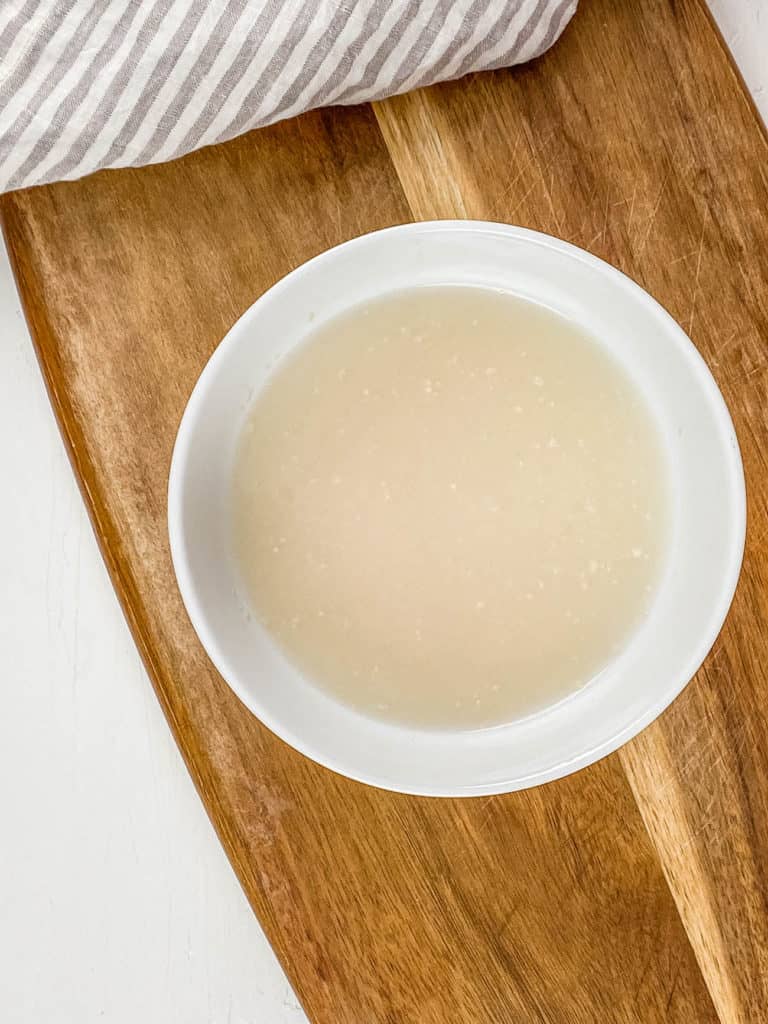
Whisk Flour: Next, I whisk together the flour and salt in a large bowl.
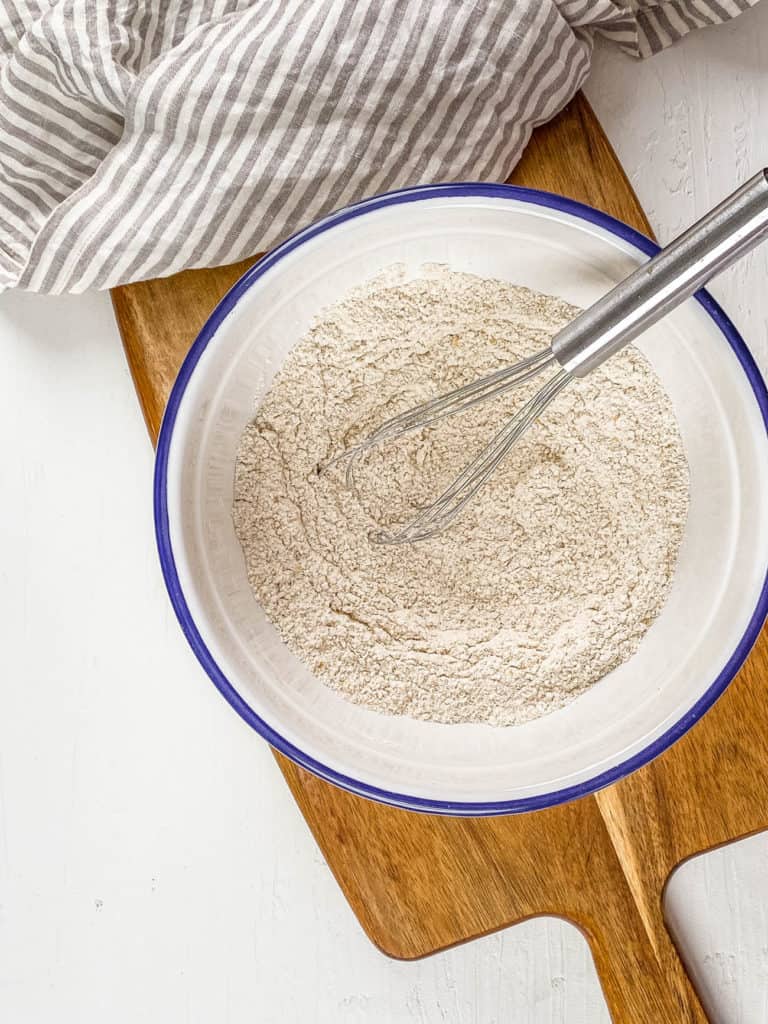
Form Dough: When the yeast mixture starts to foam, I pour it into the flour mixture along with the oil, and stir to form a dough.
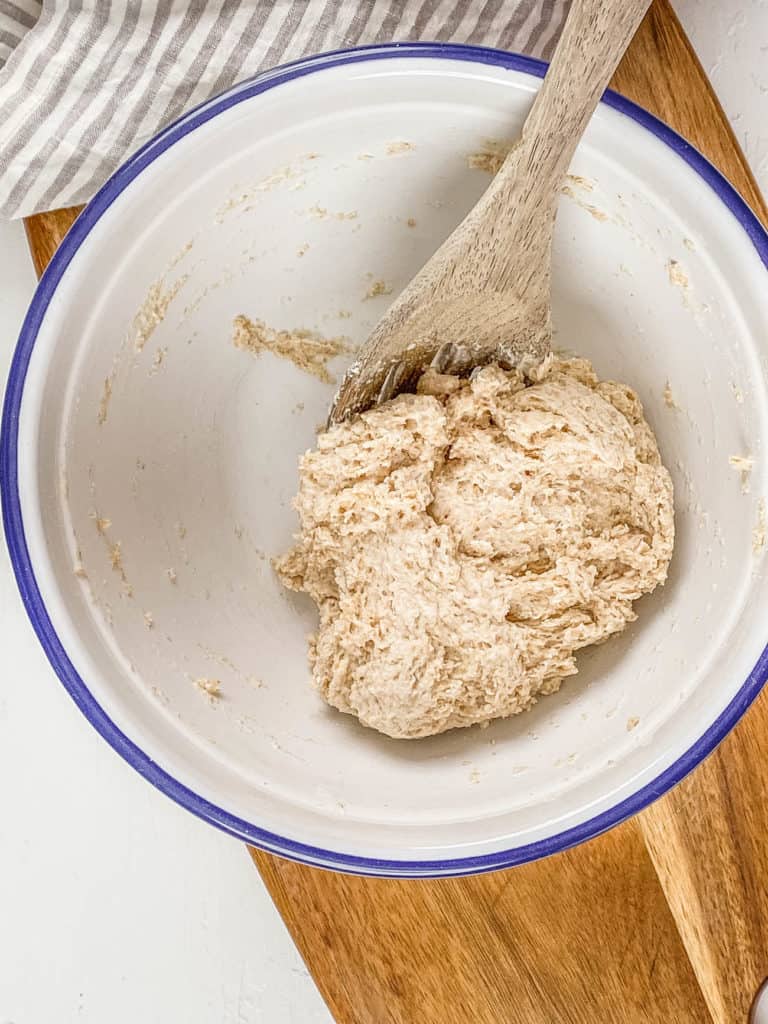
Knead Dough And Allow To Rest: Next, I turn the dough out onto a floured surface and knead with the heels of my hands for 2-3 minutes, shaping into a ball. Then, I return the ball of dough to the mixing bowl, cover and rest for 30-45 minutes to allow it to double in size.
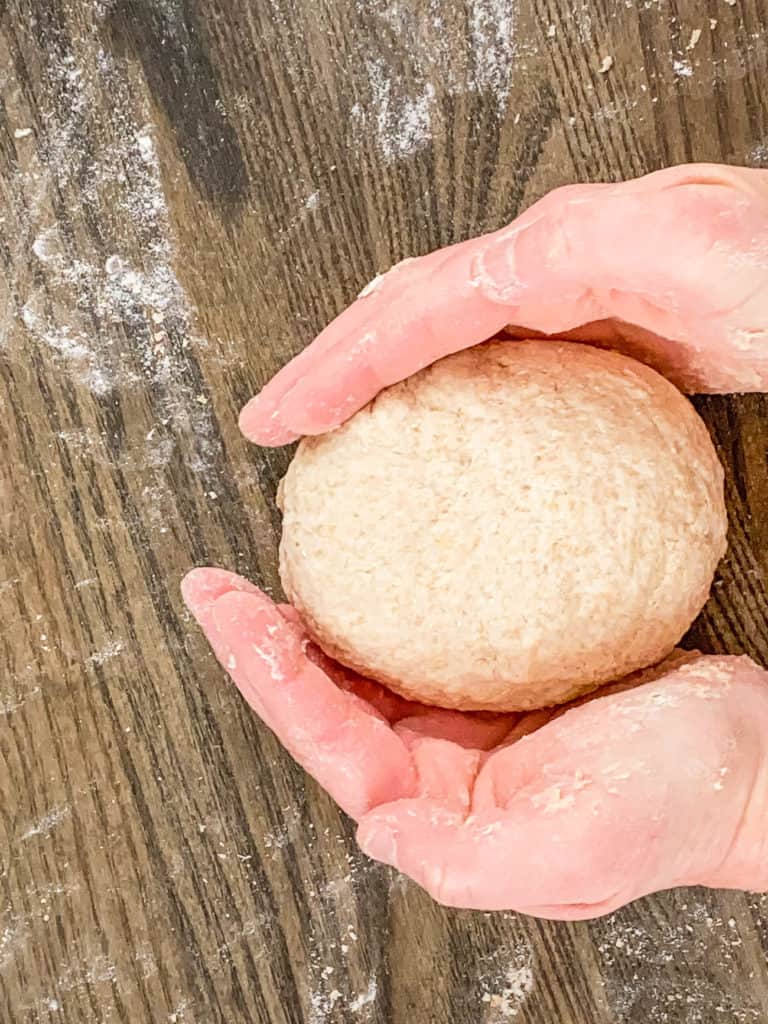
Prepare Caramelized Onions: While the dough is resting, I prepare the caramelized onions. I start by heating the oil in a large skillet over medium-high heat and add the red onion slices. I sauté the sliced onions for 2-3 minutes then I reduce the heat and continue to stir as they cook for 10 minutes. Sometimes, I’ll add a little water to stop them from sticking to the bottom of the skillet. Then, I add the coconut sugar and balsamic vinegar and stir them through.
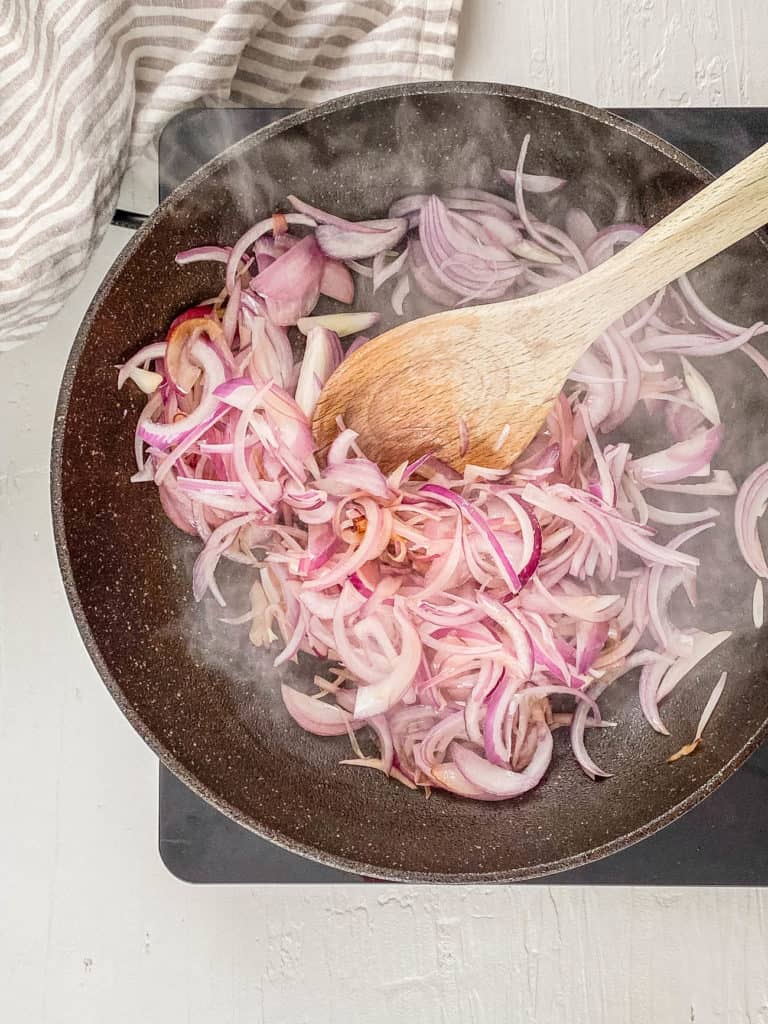
Remove From Heat: When the onions have completely caramelized, I remove them from the heat, season with salt, and set aside to cool.
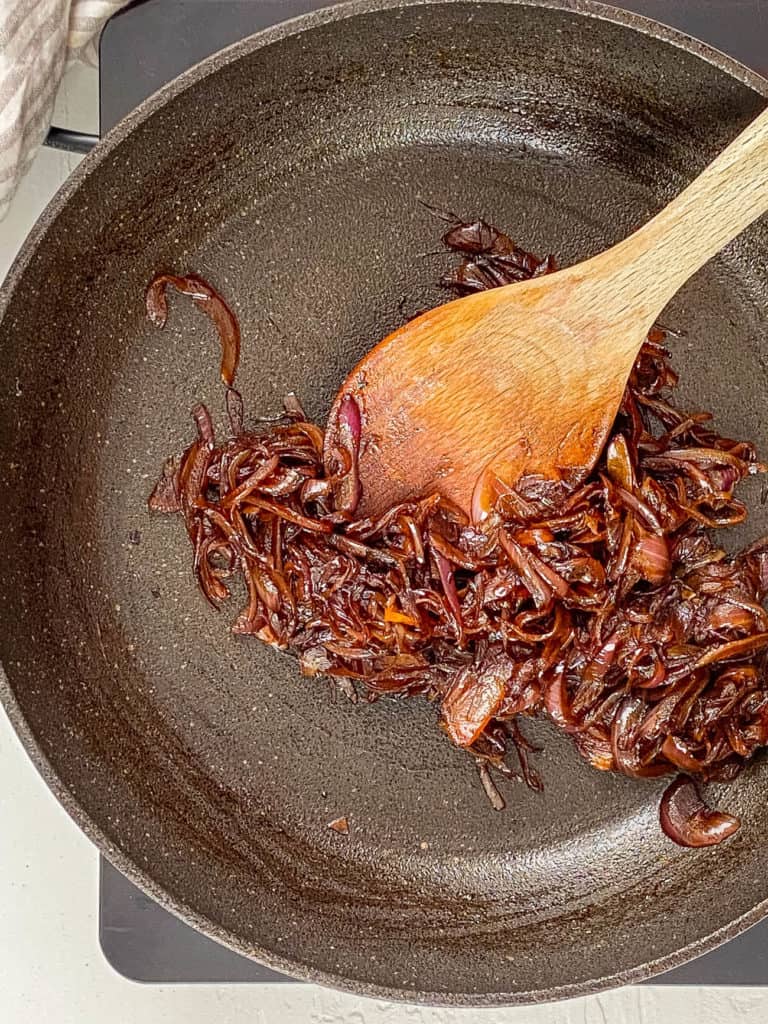
Preheat Oven: Before assembling the pizza, I’ll preheat my oven to 390 degrees Fahrenheit. If I’m using a pizza stone, I’ll place it into the oven to preheat as well.
Assemble: While the oven preheats, I’ll assemble my caramelized onion and goat cheese pizza. After the dough has doubled in size, I’ll remove it from the bowl and spread the dough into a 12 inch round on a tray lined with baking paper, or I’ll divide the dough and roll into 2 smaller pizzas.
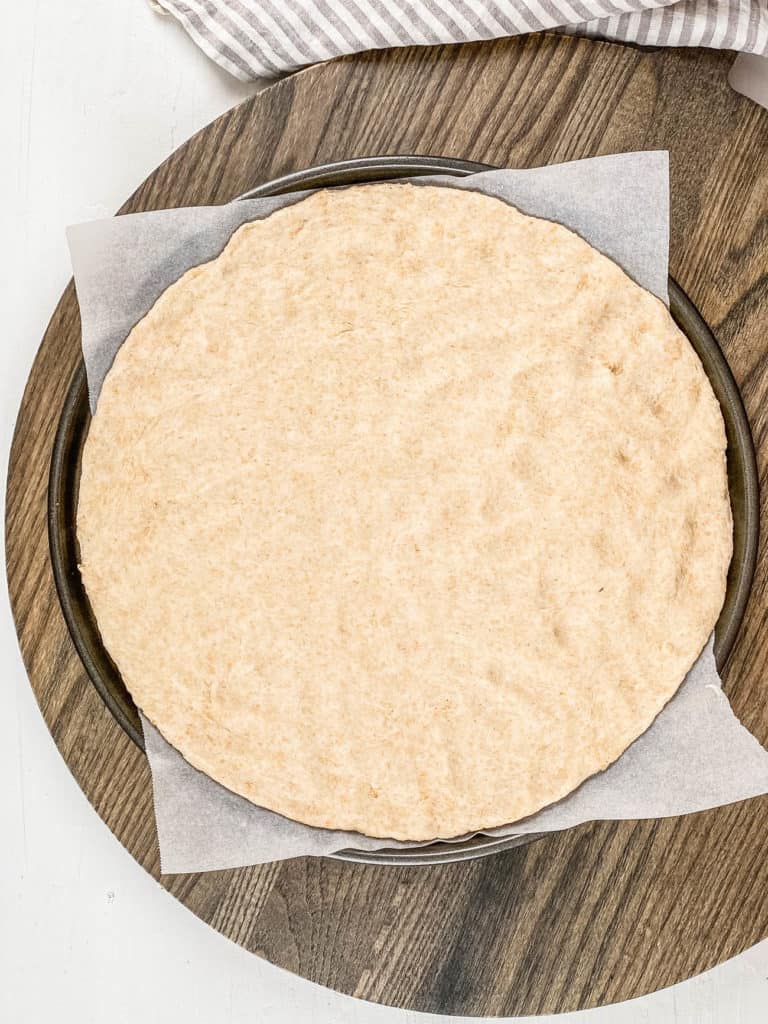
Add Toppings: Then I top the pizza dough with the caramelized onion, crumbled goat cheese, and fresh thyme, leaving a 1-inch border around the edges.
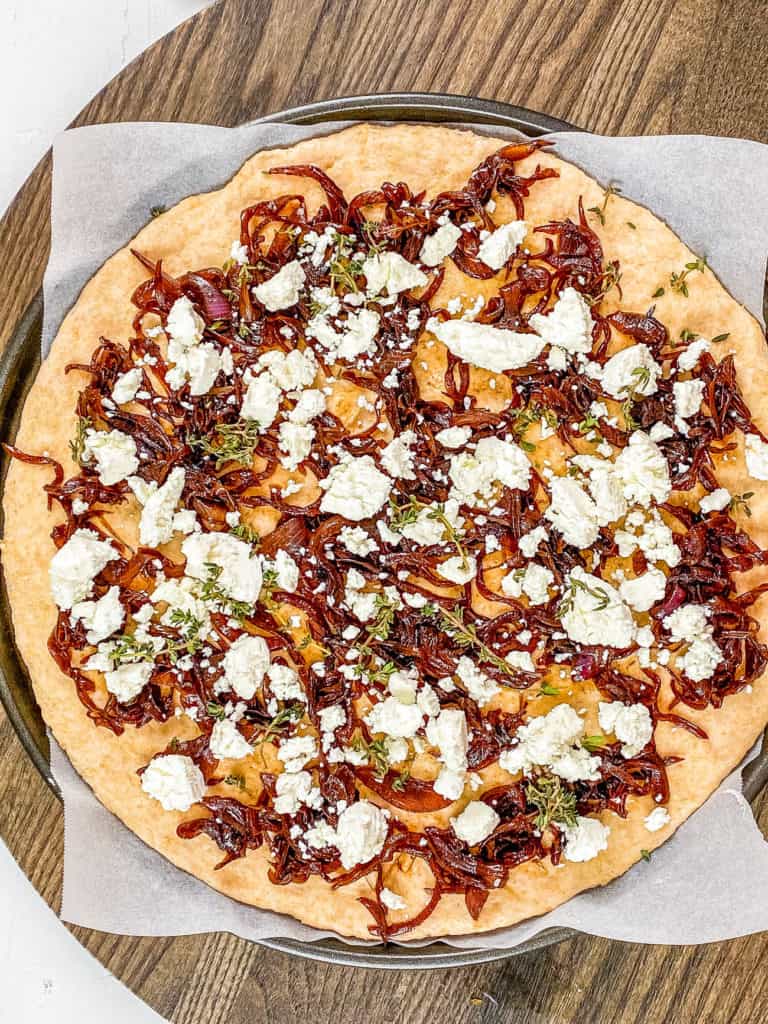
Bake Pizza: If I’m using a pizza stone, I’ll transfer the prepared pizza onto the pizza stone or cook the pizza as it is on a large baking sheet for 15-20 mins or until golden brown. Then, I’ll cut it into 8 equal pieces to serve!
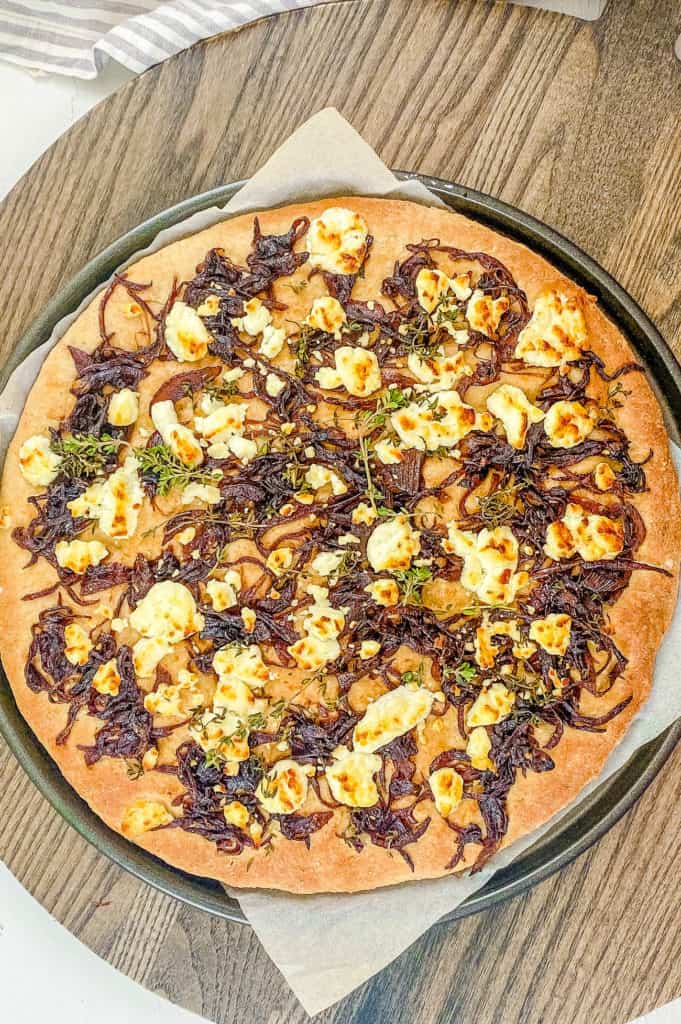
My #1 Secret Tip for this making pizza with caramelized onions and goat cheese centers around the dough. I know that homemade pizza dough can be intimidating if you’re a newer cook, but I promise, I’ve created this recipe to make it as easy as possible.
For the dough: when activating the yeast, always make sure the water is warm – never hot! Otherwise, the yeast will not activate.
Make sure to knead the dough until it just springs back when you press gently on it, and after the dough has been kneaded, I cover it and leave it in a warm place to double in size. Usually, this place is a countertop at room temperature or even inside of a cooled oven.
And if you can, invest in a pizza stone! A preheated pizza stone helps transfer heat evenly to the crust, resulting in a perfectly cooked and crispy base for your pizza.
Other Tips To Keep In Mind:
- Cook The Onions Low And Slow: I always caramelize onions over medium-low heat, stirring occasionally. This allows the sugars to slowly release and brown beautifully, resulting in a deep, sweet flavor.
- Embrace The Maillard Reaction: Don’t stir the onions constantly once they start to brown. I try to let them sit undisturbed for short periods to develop those delicious caramelized bits on the bottom of the pan, and just gently nudge them around to prevent burning.
- Topping Quantity Matters: While tempting, resist the urge to pile on too many toppings. This can weigh down the crust and make it difficult to cook through. I like to sprinkle the toppings over the crust until it’s just lightly covered.
- Change Up The Texture: Sometimes, I’m in the mood for a softer or crunchier onion. This means I’ll cook them longer for a softer texture or shorter for a crunchy bite! The texture is according to preference.
📖 Variations
Flavored Cheese: Goat cheese comes in different flavor varieties. Sometimes, I’ll use garlic and chive flavored goat cheese or another flavor to add more punch.
Additional Cheese: For a cheesier pizza, I like to add mozzarella cheese, fontina cheese, or parmesan cheese.
Additional Toppings: There are so many different toppings that go with goat cheese on pizza! For variety, I’ll add diced fresh figs, arugula, a drizzle of balsamic glaze, or some red pepper flakes for a little spice. Instead of thyme, I’ll also use fresh rosemary, lemon zest, or fresh basil. I also like adding diced red peppers, kalamata olives or sundried tomatoes!
Add Protein: If you don’t need this pizza to be vegetarian, you can top with thinly sliced pieces of chicken breast or prosciutto, or for a veggie protein option, add some pine nuts or walnuts.
Pizza Crust: If I’m short on time, I’ll use a store-bought pizza crust instead of making the pizza dough from scratch.
Add A Sauce: This healthy pizza recipe doesn’t have an added sauce, but if you like a sauce on your pizza you can add regular pizza sauce, a pesto sauce, garlic sauce, or a white sauce.
🍽 Serving Suggestions
For a complete meal, I pair this pizza with goat cheese and caramelized onions with a light salad or soup.
Salads: I serve this pizza with a keto Greek salad for some extra veggies or my apple walnut salad with a little extra protein from the nuts. My Greek farro salad or roasted pumpkin salad would be great for the Fall season.
Soups: In the cooler months, or for a heartier meal, I like to serve this pizza with my creamy asparagus soup with goat cheese, mushroom soup without cream, or Greek lentil soup.
🧊 Storage Directions
When I have leftovers, I always allow the pizza slices to cool completely and make sure to wrap each slice well with plastic wrap.
Fridge: I store this pizza in the refrigerator for up to 3 days. I wrap each of the slices in plastic wrap or aluminum foil, or transfer to an airtight container.
Make Ahead: I make pizza dough ahead of time and store it, covered in the fridge for several hours. Then, I allow it to come to room temperature before spreading on to the pizza stone or baking sheet and assembling.
Freezer: To freeze the pizza dough, I wrap the ball of dough with plastic wrap and place in a zip-top bag and freeze for up to 3 months. When pizza night comes around, I defrost in the fridge and allow it to come to room temperature before rolling it out.
Reheating: To reheat individual slices, I preheat the oven to 350 degrees Fahrenheit, and place pizza on a baking sheet. I bake for about 5-8 minutes, until warm in the center and the crust begins to crisp up.
❓Recipe FAQs
Not completely. When goat cheese is heated it softens, but it does not melt the same way mozzarella does. Whereas mozzarella gets gooey and stringy, goat cheese when warmed becomes creamier but does not get that stretchy cheesy texture.
I use plenty of flour on my hands and the work surface to prevent sticking. I also let the dough come to room temperature before stretching it to make it more pliable. Don’t be afraid to use a rolling pin if stretching by hand is too difficult.
Sometimes, when I overload my pizza with too much of the toppings, it prevents the pizza from cooking thoroughly. While it’s easy to get carried away, I try to keep the toppings as close to the measurements as possible. Also, using a pizza stone helps evenly distribute the heat along the bottom of the pizza. If you’re still having trouble with a soggy crust after trying these tips, I recommend pre-baking the crust for a few minutes before adding your toppings and that should solve the issue.

Want to Save This Recipe?
Enter your email & I’ll send it to your inbox. Plus, get great new recipes from me every week!
By submitting this form, you consent to receive emails from The Picky Eater.
Love this healthy pizza recipe? Please leave a 5-star rating 🌟 in the recipe below and/or a review in the comment section further down the page!
You can also FOLLOW ME on FACEBOOK, INSTAGRAM, and PINTEREST to see more delicious, healthy, family-friendly food, and if you have any questions, I’m here to help!
📋 Recipe Card
Goat Cheese And Caramelized Onion Pizza
This goat cheese and caramelized onion pizza is my favorite restaurant-quality meal I make at home! I love how easy this recipe is to make. The crispy crust paired with creamy goat cheese and sweet caramelized onions is a match made in heaven! My recipe is perfect for a healthier family-friendly pizza night that’s better than takeout, and more budget-friendly too.
Servings: 8 servings
Calories: 171kcal
Shop Ingredients on JupiterPrepare Caramelized Onions
- Make sure the water is warm and not hot otherwise the yeast won’t activate.
- Ensure the dough is left in a warm place to rise.
- Pizza dough can be prepared ahead of time and stored, covered in the fridge. Allow it to come to room temperature before using.
- Pizza bases can be cooked and frozen for up to 3 months.
Serving: 1slice | Calories: 171kcal | Carbohydrates: 23g | Protein: 6g | Fat: 7g | Saturated Fat: 2g | Polyunsaturated Fat: 1g | Monounsaturated Fat: 3g | Cholesterol: 6mg | Sodium: 201mg | Potassium: 142mg | Fiber: 3g | Sugar: 4g
Source link
-

 African History5 years ago
African History5 years agoA Closer Look: Afro-Mexicans 🇲🇽
-

 African History6 months ago
African History6 months agoBlack History Facts I had to Learn on My Own pt.6 📜
-

 African History5 years ago
African History5 years agoA Closer Look: Afro-Mexicans 🇲🇽
-

 African History1 year ago
African History1 year agoMajor African Tribes taken away during the Atlantic Slave Trade🌍 #slavetrade #africanamericanhistory
-

 African History1 year ago
African History1 year agoCameroon 🇨🇲 World Cup History (1962-2022) #football #realmadrid #shorts
-

 African History6 months ago
African History6 months agoBlack History Inventors: Mary Kenner 🩸
-

 African History1 year ago
African History1 year agoNo African pre-Columbus DNA? 🤯🤯 #history #mesoamerica #mexico #african
-

 African History1 year ago
African History1 year agoPROOF AFRICAN AMERICANS AIN'T FROM AFRICA DOCUMENTED EVIDENCE






